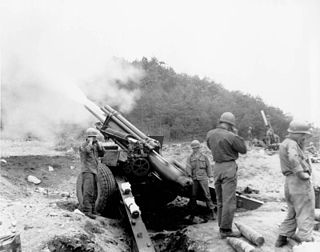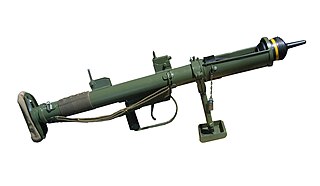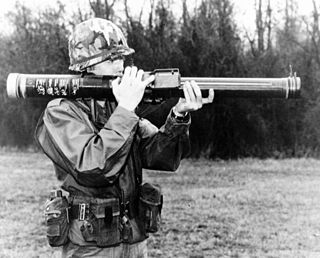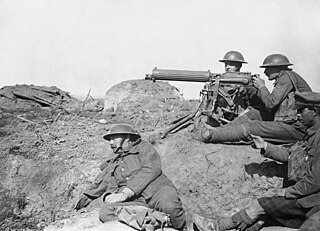
Artillery are ranged weapons that launch munitions far beyond the range and power of infantry firearms. Early artillery development focused on the ability to breach defensive walls and fortifications during sieges, and led to heavy, fairly immobile siege engines. As technology improved, lighter, more mobile field artillery cannons developed for battlefield use. This development continues today; modern self-propelled artillery vehicles are highly mobile weapons of great versatility generally providing the largest share of an army's total firepower.

The howitzer is an artillery weapon that falls between a cannon and a mortar. It is generally aimed lower than a mortar but higher than a cannon. With their long-range capabilities, howitzers can be used to great effect in a battery formation with other artillery pieces, such as long-barreled guns, mortars, and rocket artillery.

Self-propelled artillery is artillery equipped with its own propulsion system to move toward its firing position. Within the terminology are the self-propelled gun, self-propelled howitzer, self-propelled mortar, and self-propelled rocket artillery. They are high mobility vehicles, usually based on continuous tracks carrying either a large field gun, howitzer, mortar, or some form of rocket/missile launcher. They are usually used for long-range indirect bombardment support on the battlefield.

A field gun is a field artillery piece. Originally the term referred to smaller guns that could accompany a field army on the march, that when in combat could be moved about the battlefield in response to changing circumstances, as opposed to guns installed in a fort, or to siege cannons and mortars which are too large to be moved quickly, and would be used only in a prolonged siege.

Indirect fire is aiming and firing a projectile without relying on a direct line of sight between the gun and its target, as in the case of direct fire. Aiming is performed by calculating azimuth and inclination, and may include correcting aim by observing the fall of shot and calculating new angles.

The Projector, Infantry, Anti Tank (PIAT) Mk I was a British man-portable anti-tank weapon developed during the Second World War. The PIAT was designed in 1942 in response to the British Army's need for a more effective infantry anti-tank weapon and entered service in 1943.

Anti-tank warfare originated during World War I from the desire to develop technology and tactics to destroy tanks. After the Allies deployed the first tanks in 1916, the German Empire introduced the first anti-tank weapons. The first developed anti-tank weapon was a scaled-up bolt-action rifle, the Mauser 1918 T-Gewehr, that fired a 13.2 mm cartridge with a solid bullet that could penetrate the thin armor used by tanks at that time and destroy the engine or ricochet inside, killing occupants. Because tanks represent an enemy's strong force projection on land, military strategists have incorporated anti-tank warfare into the doctrine of nearly every combat service since. The most predominant anti-tank weapons at the start of World War II in 1939 included the tank-mounted gun, anti-tank guns and anti-tank grenades used by the infantry, and ground-attack aircraft.

A mortar is today usually a simple, lightweight, man-portable, muzzle-loaded cannon, consisting of a smooth-bore metal tube fixed to a base plate with a lightweight bipod mount and a sight. Mortars are typically used as indirect fire weapons for close fire support with a variety of ammunition. Historically mortars were heavy siege artillery. Mortars launch explosive shells in high-arching ballistic trajectories.

Technology during World War I (1914–1918) reflected a trend toward industrialism and the application of mass-production methods to weapons and to the technology of warfare in general. This trend began at least fifty years prior to World War I during the American Civil War of 1861–1865, and continued through many smaller conflicts in which soldiers and strategists tested new weapons.

Enfilade and defilade are concepts in military tactics used to describe a military formation's exposure to enemy fire. A formation or position is "in enfilade" if weapon fire can be directed along its longest axis. A unit or position is "in defilade" if it uses natural or artificial obstacles to shield or conceal itself from enfilade and hostile fire. The strategies, named by the English during the Hundred Years' War, use the French enfiler and défiler spoken by English nobility of the time.

In military science, suppressive fire is "fire that degrades the performance of an enemy force below the level needed to fulfill its mission". When used to protect exposed friendly troops advancing on the battlefield, it is commonly called covering fire. Suppression is usually only effective for the duration of the fire. It is one of three types of fire support, which is defined by NATO as "the application of fire, coordinated with the maneuver of forces, to destroy, neutralise or suppress the enemy".

The FN MAG is a Belgian 7.62 mm general-purpose machine gun, designed in the early 1950s at Fabrique Nationale (FN) by Ernest Vervier. It has been used by more than 80 countries and it has been made under licence in several countries, including Argentina, Canada, Egypt, India and the United Kingdom.

An artillery observer, artillery spotter, or forward observer (FO) is a soldier responsible for directing artillery and mortar fire support onto a target. An artillery observer usually accompanies a tank or infantry unit. Spotters ensure that indirect fire hits targets which those at a fire support base cannot see.

Infantry tactics are the combination of military concepts and methods used by infantry to achieve tactical objectives during combat. The role of the infantry on the battlefield is, typically, to close with and engage the enemy, and hold territorial objectives; infantry tactics are the means by which this is achieved. Infantry commonly makes up the largest proportion of an army's fighting strength, and consequently often suffers the heaviest casualties. Throughout history, infantrymen have sought to minimise their losses in both attack and defence through effective tactics.

The artillery of World War I, improved over that used in previous wars, influenced the tactics, operations, and strategies that were used by the belligerents. This led to trench warfare and encouraged efforts to break the resulting stalemate at the front. World War I raised artillery to a new level of importance on the battlefield.

The PAW 600 was a lightweight anti-tank gun that used the high-low pressure system to fire hollow charge warheads. In 1945, it was used operationally by the Wehrmacht in small numbers. Only about 260 were produced before the war's end.
List of abbreviations, acronyms and initials related to military subjects such as modern armour, artillery, infantry, and weapons, along with their definitions.
Grazing fire is a term used in military science and defined by NATO and the United States Department of Defense as "Fire approximately parallel to the ground where the center of the cone of fire does not rise above one meter from the ground." Grazing fire is often performed by machine guns. It is tactically advantageous when attempting to cut off an infantry ground assault or counter-attack.

Direct fire or line-of-sight fire refers to firing of a ranged weapon whose projectile is launched directly at a target within the line-of-sight of the user. The firing weapon must have a sighting device and an unobstructed view to the target, which means no obstacles or friendly units can be between it and the target. A weapon engaged in direct fire conversely exposes itself to direct return fire from the target.

















